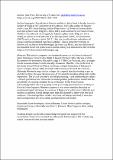Parisian Palimpsests and Creole Creations : Mme Marsan and Dlle Minette play Nina on the Caribbean Stage
Abstract
This article compares the theatrical careers in the French colony of Saint-Domingue (present-day Haiti) of two performers: Mme Marsan, a white European who dominated the public stage in 1780s Cap-Français, and a younger Creole woman of mixed racial ancestry, known as ‘Minette’, who performed in her home town of Port-au-Prince. Its focus is on performances of Dalayrac’s opéra-comique, Nina (1786), in which both women performed the lead role. Although Minette is regarded as a singer, it is argued that, by electing to put on and star in Nina, she was taking on one of the most demanding acting roles in the repertoire. The article considers the self-positioning – and positioning by others – of both performers in relation to the metropolitan performance model and the possibility of creating creolized forms of theatre. While Mme Marsan acknowledged that she was playing a role previously performed successfully in Paris by Mme Dugazon, Minette’s approach was more complex: drawing on unacknowledged references to a review of Dugazon’s performance, Minette also invoked a common Creole background that she claimed to share with her local audience. The metropolitan ‘model’ was thus not always imitated; it was also used as inspiration for new, subtly creolized forms of theatre.
Citation
Prest , J 2019 , ' Parisian Palimpsests and Creole Creations : Mme Marsan and Dlle Minette play Nina on the Caribbean Stage ' , Early Modern French Studies , vol. Latest Articles . https://doi.org/10.1080/20563035.2019.1592813
Publication
Early Modern French Studies
Status
Peer reviewed
ISSN
2056-3035Type
Journal article
Description
The author acknowledges the generous support of The Leverhulme Trust, who awarded a Research Fellowship in 2017-18.Collections
Items in the St Andrews Research Repository are protected by copyright, with all rights reserved, unless otherwise indicated.

